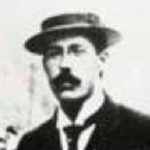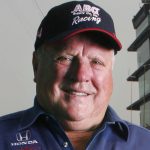The short biography of Charles B. King reads that he was the first person to design, build and drive a car on the streets of old Detroit. But Charles Brady King was nothing short of a genius, the most technically knowledgeable of the early automotive pioneers and one of a handful of men who could envision the automobile as a part of everyday life. To say that Charles B. King was a “renaissance man” would be an understatement. He was an accomplished artist, architect, poet, musician and engineer, and his talents were only surpassed by his vision.
King was born in California, the son of a Civil War Union Army general. After receiving training in mechanical engineering from Cornell University, he moved to Detroit in 1889 at the age of 21, “bursting with ideas “. It is safe to say that had King NOT brought his talents to Detroit, that city would have had a much more difficult time establishing itself as the center of the auto industry. Upon visiting the Chicago Exposition in 1893 and seeing Gottlieb Daimler’s self-propelled carriage, King set about to build a horseless carriage of his own. And learning that New England’s Duryea Brothers, Charles and Frank, had already built and tested an automobile, King knew he had no time to waste. On March 6, 1896, ten years after Carl Benz patented the first gasoline automobile in Germany, and three years after the Duryea Brothers’ first vehicle, Charles King became the first driver of a gasoline automobile in Detroit. Ironically, King was followed by Henry Ford, who was riding a bicycle. It would be another three months before Ford would test-drive his first car. King’s momentous first drive started when he steered his vehicle down St. Antoine Street to Jefferson Avenue, and then swung north on Detroit’s famous Woodward Avenue to Grand Boulevard, at which time he turned around and headed home, only to be greeted by a policeman who threatened to ticket him for disturbing the piece. The drive was accomplished in full view of hundreds of spectators, who were thrilled with what they were seeing. The Detroit Free Press newspaper had this to say the next morning: “The first horseless carriage seen in this city was out on the streets last night. It is the invention of Charles B. King, a Detroiter, and its progress up down Woodward Avenue about 11 o’clock caused a deal of comment, people crowding around it so that its progress was impeded. The apparatus seemed to work all right, and went at the rate of five or six miles an hour at an even rate of speed.” The Detroit Journal, which interviewed King, and reported what was to be his most famous quote regarding the future of the automobile: “I am convinced,” he said, “that, in time, the horseless carriage will supercede the horse.”
Charles B. King served as a mentor to Henry Ford, Ransom Olds, Jonathan Maxwell, Henry Joy and others. In fact, he provided parts, instructed and assisted Henry Ford on his first Quadricycle, at the same time he worked on his own car. In 1903, King became chief engineer of the Northern Motor Car Co., where he designed the two-cylinder “Silent Northern” – the automobile with the first three-point suspension, integrated motor and transmission assembly and the first running boards. On the 1907 Northern, he designed air brakes, an air-controlled clutch and other innovations for which he was granted patents. In 1908, King left the company and spent two years in Europe studying automotive design. He returned to Detroit in 1910, and launched the King Motor Car Co. and was the first automaker to utilize left-hand steering, center controls and the first successful V-8 engine. The King “Eight” was billed as “The Car of No Regrets.” In fact, at the New York Auto Show in 1912, the King automobile was the only vehicle to feature left-hand steering a center controls, features that would soon become the industry standard for all automobiles. At that time, he already had over 40 automotive patents to his credit.
He left his company in 1912, devoting his time to working on numerous other experiments and inventions. In 1939, in an effort to remember the early days of the auto industry and to honor its pioneers and leaders, he was a founding member of the Automobile Old Timers, the original name of what was to become the Automotive Hall of Fame.


